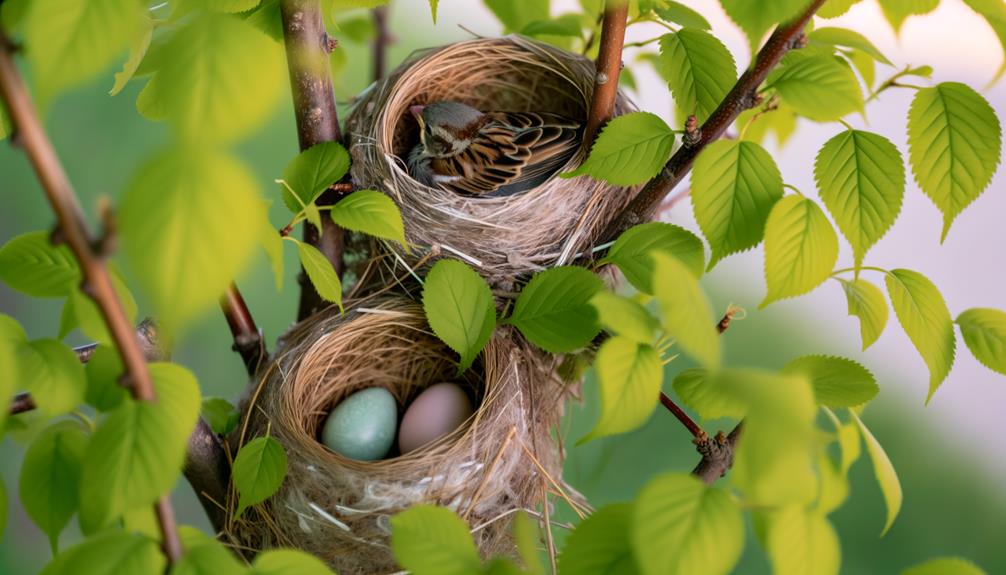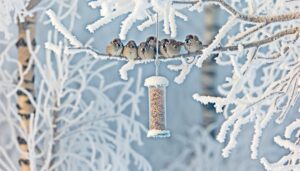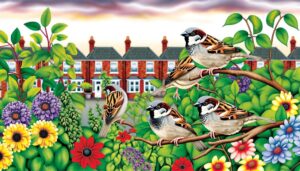How Many Eggs Do Sparrows and House Finches Lay: A Guide
Sparrows typically lay 3 to 5 eggs per clutch. House finches generally lay 4 to 5 eggs per clutch.
These clutch sizes can vary due to environmental factors, food availability, and seasonal timing. Incubation periods for both species range from 11 to 14 days.
Post-hatching, chicks require significant parental care. The choice of nesting sites, predator presence, and habitat quality are essential in determining egg production.
Seasonal conditions profoundly impact reproductive cycles, with peak egg-laying occurring in spring and early summer. Further exploration into these species reveals intricate nesting behaviors and environmental adaptations.

Key Takeaways
- Sparrows lay 3 to 5 eggs per clutch.
- House finches lay 4 to 5 eggs per clutch.
- Environmental conditions and resource availability impact clutch sizes.
- Peak egg-laying periods are in spring and early summer.
- Incubation periods for both species range from 11 to 14 days.
Sparrow Egg Laying Patterns
Sparrows typically lay between three to five eggs per clutch, with variations depending on the species and environmental conditions.
The Passer domesticus, commonly known as the house sparrow, typically produces clutches of four to five eggs.
Factors such as food availability, climate, and predation risks greatly influence clutch size. In temperate regions, sparrows may exhibit increased clutch sizes compared to their counterparts in harsher environments.
Egg incubation periods range from 11 to 14 days, with both male and female sparrows participating in the incubation process.
Post-hatching, the altricial chicks are highly dependent on parental care, requiring extensive feeding and protection.
Understanding these reproductive patterns is essential for avian ecologists and conservationists in monitoring sparrow populations and their ecological impacts.
House Finch Egg Laying Patterns
House finches (Haemorhous mexicanus) typically lay clutches of four to five eggs, with variations influenced by factors such as geographical location and environmental conditions. The egg-laying patterns of house finches exhibit notable adaptability. This adaptability is evident in several observed patterns:
- Geographical Variation: Populations in northern regions may lay larger clutches compared to those in southern locales.
- Seasonal Timing: The timing within the breeding season can affect clutch size, with earlier clutches generally being larger.
- Nutritional Availability: Adequate food supply correlates positively with clutch size, underscoring the importance of resource abundance.
- Environmental Stressors: Adverse weather conditions and predation pressures can lead to reduced clutch sizes.
Understanding these patterns provides insights into the reproductive strategies of house finches.
Typical Sparrow Clutch Size
Sparrows typically lay clutches consisting of 3 to 5 eggs, though this number can vary based on seasonal factors. Variations in clutch size are often influenced by environmental conditions and food availability during different breeding seasons.
Additionally, the choice of nesting site can impact clutch size, with more secure or resource-rich locations often supporting larger clutches.
Common Clutch Numbers
Typically, the clutch size of sparrows ranges from three to five eggs per breeding cycle. This range is influenced by several biological and environmental factors. The common clutch numbers for sparrows are important for understanding their reproductive strategies and population dynamics.
Importantly, the following points highlight key aspects of sparrow clutch sizes:
- Clutch Size Range: Sparrows generally lay between 3 and 5 eggs, with an average of 4 eggs per clutch.
- Incubation Period: The incubation period spans approximately 11 to 14 days.
- Hatching Success Rate: On average, about 80% of eggs hatch successfully under best conditions.
- Nestling Period: After hatching, the nestling period lasts around 14 to 17 days before fledglings leave the nest.
Understanding these parameters is necessary for avian ecological studies.
Seasonal Clutch Variations
Seasonal variations greatly influence the clutch size of sparrows. Fluctuations are observed in response to changes in environmental conditions and food availability. During the spring, when resources are abundant, sparrows typically lay larger clutches, averaging 4 to 5 eggs.
Conversely, in harsher conditions such as late summer or early autumn, clutch sizes tend to decrease, often comprising only 2 to 3 eggs. This adaptive reproductive strategy ensures best survival rates for the offspring, aligning the number of eggs laid with the capacity of the environment to support them.
Additionally, temperature and photoperiod variations can modulate reproductive timing, indirectly influencing clutch size. Understanding these seasonal dynamics is essential for ecological studies and conservation efforts targeting sparrow populations.
Nesting Site Impact
The choice of nesting sites significantly influences the typical clutch size of sparrows. Variations are observed based on the safety, temperature stability, and proximity to food sources provided by the chosen location. Ideal nesting sites contribute to larger clutches, enhancing the survival rate of offspring.
Key factors influencing clutch size include:
- Safety from Predators: Secure nesting sites diminish predation risks, allowing for larger clutch sizes.
- Temperature Stability: Sites with consistent temperatures result in better incubation conditions, promoting larger clutches.
- Proximity to Food Sources: Access to abundant food resources supports the energy demands of raising more offspring.
- Human Disturbance: Minimizing human interference at nesting sites leads to higher reproductive success and hence larger clutches.
These factors collectively determine the reproductive output of sparrows.
Typical House Finch Clutch Size
The typical clutch size of House Finches (Haemorhous mexicanus) averages between 4 to 5 eggs per breeding attempt.
Seasonal variations influence clutch size, with larger clutches observed during early spring.
House Finches exhibit preferences for nesting in sheltered locations, often utilizing cavities or man-made structures.
Average Clutch Size
Typically, a House Finch (Haemorhous mexicanus) clutch comprises 4 to 5 eggs. This clutch size is influenced by several factors, which are essential for understanding reproductive strategies and population dynamics.
Here are key points about the average clutch size:
- Eggs per Clutch: House Finches generally lay between 4 and 5 eggs per clutch, aligning with their reproductive strategy to maximize offspring survival.
- Incubation Period: The incubation period for House Finch eggs typically lasts 12 to 14 days.
- Nest Site Selection: The choice of nesting site can impact clutch size, with more secure locations potentially supporting larger clutches.
- Parental Investment: Both male and female House Finches contribute to feeding and protecting the young, which can influence the number of eggs laid.
Understanding these factors provides insight into the reproductive ecology of House Finches.
Seasonal Variations
Seasonal variations greatly influence the clutch size of House Finches, with larger clutches often observed during the spring and early summer months. The reproductive strategy adjusts to optimize offspring survival rates, thereby varying clutch size according to environmental factors. During peak breeding season, clutch sizes can range between 4 to 6 eggs. Conversely, in late summer and early fall, clutch sizes typically diminish. These fluctuations reflect the availability of resources and favorable climatic conditions. The table below summarizes the typical clutch sizes observed during different seasons.
| Season | Clutch Size Range | Average Clutch Size |
|---|---|---|
| Spring | 4–6 | 5 |
| Early Summer | 4–6 | 5 |
| Late Summer | 3–5 | 4 |
| Early Fall | 3–4 | 3.5 |
Understanding these patterns is essential for conservation and ecological studies.
Nesting Preferences
Nesting preferences for House Finches are influenced by factors such as habitat availability, predation risk, and microclimatic conditions, which collectively determine the typical clutch size. Research indicates that House Finches generally lay a clutch of 3 to 6 eggs.
The following factors critically influence clutch size:
- Habitat Availability: Adequate nesting sites, such as trees and shrubs, support larger clutches.
- Predation Risk: Increased predation pressure typically results in smaller clutch sizes to enhance survival rates.
- Microclimatic Conditions: Temperature and humidity levels directly affect egg viability and clutch size.
- Food Supply: Abundant resources correlate with larger clutches, facilitating greater reproductive success.
Understanding these nesting preferences is essential for conservation and habitat management strategies.
Factors Affecting Sparrow Egg Laying
Several factors influence the egg-laying patterns of sparrows, including environmental conditions, availability of resources, and predation pressures.
Temperature fluctuations can impact reproductive cycles, with best egg-laying occurring during temperate climates.
Resource availability, particularly food supply, directly correlates with clutch size; ample food resources enable sparrows to lay more eggs.
Nesting materials also play a critical role, as insufficient materials can limit reproductive success.
Moreover, predation pressures from avian and mammalian predators can induce stress, thereby reducing egg production.
Studies have shown that in high-predation areas, sparrows tend to lay fewer eggs or may even abandon nests altogether.
These factors collectively determine the reproductive output and success of sparrow populations in varying ecological contexts.
Factors Affecting House Finch Egg Laying
Environmental factors, resource availability, and predation pressures greatly influence the egg-laying patterns of house finches.
Key factors include:
- Temperature: Ideal temperatures promote higher reproductive success, while extreme temperatures can hinder egg production.
- Food Supply: Abundant food resources correlate with increased egg-laying frequency, as nutritional intake directly affects reproductive health.
- Predator Presence: Elevated predation risk can lead to reduced egg-laying rates as energy is diverted to survival mechanisms.
- Habitat Quality: High-quality habitats with ample nesting sites and minimal disturbances contribute to higher egg-laying rates, ensuring better offspring survival.
Understanding these factors provides insights into the reproductive strategies of house finches and aids in conservation efforts by identifying critical environmental and ecological needs.
Seasonal Variations in Egg Laying
Seasonal changes profoundly impact the egg-laying patterns of sparrows and house finches. Peak reproductive activity typically occurs during spring and early summer. Ideal environmental conditions, such as increased daylight and abundant food resources, stimulate reproductive hormones during these periods.
House finches (Haemorhous mexicanus) and sparrows (Passer domesticus) adjust their laying frequency. Sparrows lay 3-7 eggs per clutch, while house finches lay 2-6 eggs per clutch. Incubation periods also vary, generally lasting 11-14 days for both species.
The synchronization of breeding cycles with favorable weather conditions ensures higher survival rates for hatchlings. Seasonal shifts in temperature and food availability greatly influence reproductive timing and success, emphasizing the importance of environmental cues in avian reproductive strategies.
Nesting Habits and Locations
Understanding the nesting habits and locations of sparrows and house finches is essential to comprehending their reproductive strategies. Both species exhibit distinct preferences in their nesting sites and construction techniques.
Sparrows are known to nest in a variety of locations, including building eaves, tree branches, and even man-made structures. House finches, on the other hand, prefer more concealed and sheltered areas such as dense foliage and hanging baskets.
Key nesting characteristics include:
- Sparrow nests: Open cup structure, composed of grass, twigs, and feathers.
- House finch nests: Cup-shaped, constructed with fine grasses and animal hair.
- Nesting height: Varies from ground level to several meters high.
- Breeding season: Typically from early spring to late summer.
These preferences greatly influence their reproductive success and survival rates.
Conclusion
The intricacies of avian reproduction reveal the delicate dance between biology and environment. Sparrows and house finches, each with their distinct clutch sizes and egg-laying patterns, embody nature's adaptability.
External factors such as habitat conditions and seasonal variations orchestrate this symphony of life, influencing reproductive success. The nesting habits and locations of these birds further paint a vivid tableau of survival strategies.
Understanding these patterns enriches the tapestry of ornithological knowledge, reflecting the nuanced interplay of life's perpetual cycle.






